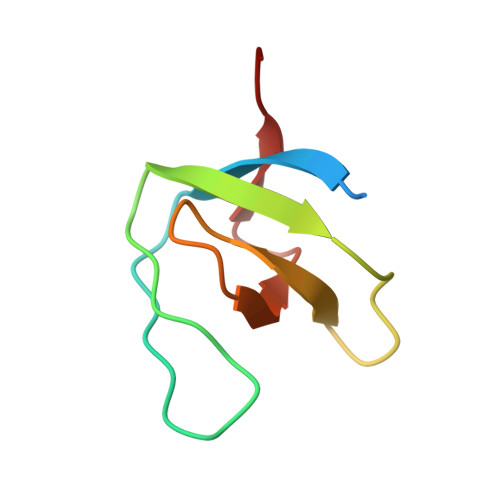Solution NMR structure of the SH3 domain of human nephrocystin and analysis of a mutation-causing juvenile nephronophthisis.
le Maire, A., Weber, T., Saunier, S., Broutin, I., Antignac, C., Ducruix, A., Dardel, F.(2005) Proteins 59: 347-355
- PubMed: 15723349
- DOI: https://doi.org/10.1002/prot.20344
- Primary Citation of Related Structures:
1S1N - PubMed Abstract:
Human nephrocystin is a protein associated with juvenile NPH, an autosomal recessive, inherited kidney disease responsible for chronic renal failure in children. It contains an SH3 domain involved in signaling pathways controlling cell adhesion and cytoskeleton organization. The solution structure of this domain was solved by triple resonance NMR spectroscopy. Within the core, the structure is similar to those previously reported for other SH3 domains but exhibits a number of specific noncanonical features within the polyproline ligand binding site. Some of the key conserved residues are missing, and the N-Src loop exhibits an unusual twisted geometry, which results in a narrowing of the binding groove. This is induced by the replacement of a conserved Asp, Asn, or Glu residue by a Pro at one side of the N-Src loop. A systematic survey of other SH3 domains also containing a Pro at this position reveals that most of them belong to proteins involved in cell adhesion or motility. A variant of this domain, which carries a point mutation causing NPH, was also analyzed. This change, L180P, although it corresponds to a nonconserved and solvent-exposed position, causes a complete loss of the tertiary structure. Similar effects are also observed with the L180A variant. This could be a context-dependent effect resulting from an interaction between neighboring charged side-chains.
Organizational Affiliation:
Laboratoire de Cristallographie et RMN Biologiques, UMR8015 CNRS, Faculté de Pharmacie, Université Paris 5, Paris, France.














